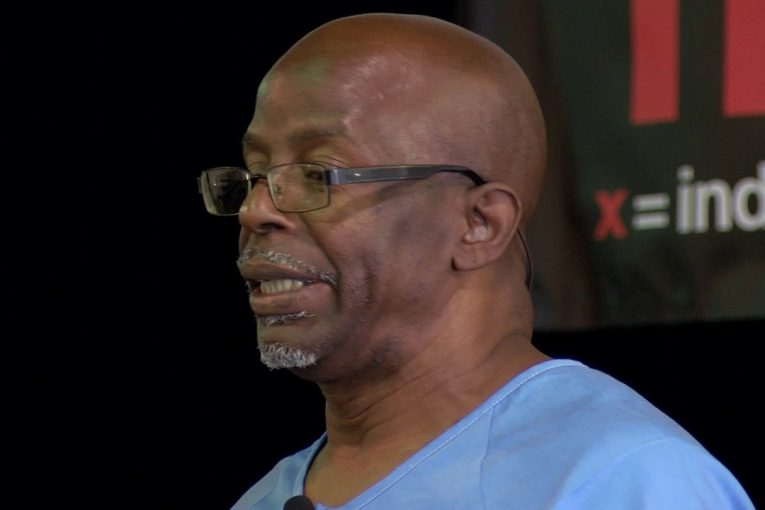

By Alexander Ramirez, Ramneet Singh and Lauren Smith
WOODLAND, CA – After about 35 years incarcerated, Lionel Ernest Tholmer, convicted of murdering a mother and her three-year-old child as well as his ex-wife’s stepfather, may be not guilty.
According to the National Registry of Exonerations, if Tholmer were to be exonerated today, he would walk out of prison after having served more time than all but 18 of the 2,796 men and women who spent the longest time in prison for a wrongful conviction.
John Meadows
On November 7, 1985 the body of John Meadows was found in a brushy area near Foresthill Road. Tholmer, who was 27 at the time, claimed that Meadows lured him into the dark secluded area and drew a gun on him, forcing him to defend himself.
After a struggle over the weapon, Meadows was shot two times, with the weapon discharging three times. Tholmer stated that he then fled the area by car, having no idea what the extent of the injuries were.
The next day, Tholmer inquired around town as to whether any of Meadows’ family or friends had seen the man, but when no one stated they had, he went back to the site of their altercation and found Meadows dead a relatively short distance from where the shooting had occurred.
Panicked that the police wouldn’t believe that he shot Meadows in self-defense, Tholmer retrieved a can of gas from his trunk and burned Meadows’ lifeless body in an effort to hide any  potential evidence of his involvement.
potential evidence of his involvement.
The prosecution would later use this incident to assert the guilt of Tholmer in a second major case, the murder of Cynthia Sparpana and the disappearance of her daughter.
Police received a map from an anonymous person, who they later claimed was Tholmer, with directions leading them to Meadows’ body. Tholmer denies that he drew and sent any such map and theorizes that because the area was a trail-head frequented by lovers, drug-users, and hikers, someone not wanting to get involved must have provided the map.
Police immediately suspected Tholmer because witnesses had seen Meadows and Tholmer together around town the day Meadows was murdered.
Tholmer was later arrested in Oklahoma on Dec. 9, 1985 at a shuttle station while speaking with his estranged wife on a pay phone. Her line was being traced.
John Kane, a Sacramento Police Department Lieutenant who claimed that he had a previous history with Tholmer, involved himself in the case once it made the local news.
In a letter recently written to Sacramento Police Department Chief of Police Daniel Hahn, Tholmer vigorously disputes the characterization made by Kane of their relationship and accuses Kane of felony false reporting amongst other equally serious accusations.
He writes, “[Lt. Kane] made entirely false claims to other law enforcement in California that I had contacted him while on the run and would only speak to him and he further told these investigating agencies that I had also made threats against him to the officers in Oklahoma City who took me into custody. These extraditing officers clearly went on record confirming that I made no such statements to them about Lt. Kane.”
After his arrest, he was interrogated about Meadows’ murder.
While detained Tholmer exercised his right to remain silent multiple times between his arrest in Oklahoma and when he was transported back to California.
In a series of interrogations, and attempts to interrogate, Tholmer continuously refused to talk to Kane and other officers, asserting his right to remain silent. He repeatedly requested the presence of his lawyer. On several occasions however, under what he explains was significant duress, he did speak with no lawyer present.
At one point during Tholmer’s preliminary hearing he was removed against his will from the Placer County Jail.
Even after telling jail staff he would not speak to Kane and fellow officer Penny Welsch, who had shown up unannounced from a different jurisdiction, a Sgt. Triebwasser entered the cell with a trained police dog in order to force Tholmer out. This tactic worked and Tholmer, in fear, went with the officers.
Tholmer was then taken to a Yolo County police substation where then District Attorney David Henderson and Deputy District Attorney Steven Mock interrogated him with the help of Lt. Kane, who admittedly had no jurisdiction in the case.
They were seeking information about another case, the murder of Cynthia Sparpana and the disappearance of her young daughter Danyel, which had taken place just prior to the death of Meadows.
Kane made statements to the media at the time that Tholmer signed some documents during that interview, but would not say what those documents were. The document would turn out to be an immunity agreement that stated if Tholmer could provide useful information about the Sparpana case and was not himself involved as the perpetrator or directly culpable, he would not be prosecuted.
Desperate to return to custody at this point, Tholmer signed what was put in front of him. After all, if he had no knowledge of the Sparpana case, what did he have to lose, he now states.
Statements allegedly made in this interview along with the documents Tholmer says he was coerced into signing were used against him, and fearing for his safety, he just wanted to get back to his housing unit stated, “I said anything that would satisfy them just to get away from there.”
During the Meadows trial, Pathologist Anthony Cunha indicated that Meadows had been burned while alive.
Much later, Cunha revealed that he was not qualified to assess the previous claim and had misidentified the substance he had testified was soot in Meadows’ trachea.
Forensics, by then, had determined that there was no soot found in Meadows’ body and therefore he had not been breathing as he was burned- but this was years after Tholmer had already been convicted.
The prosecution’s entire theory hinged on this evidence because burning Meadows alive in the location where he had been found would entirely dispute Tholmer’s version of events and paint him as a murderer, not a man who had killed in self-defense.
The defense presented significant evidence disputing the prosecution’s theories of the killing and the physical evidence at the scene seems to have supported the defense.
Tholmer, who weighed nearly 50 pounds less than Meadows, would have had to carry Meadows through, or over, a five-stranded and very high barbed wire fence and across rough terrain in the black of night without ever getting a scratch from that fence on himself or the dying man.
No physical evidence other than blood spatter was found on the barbed wire. No drag marks through the grass were found. No drag marks or dirt were found on Meadows’ shoes or clothing, nor bloody footprints- there was no credible evidence that indicated John Meadows had gotten to the place where he died other than on his own.
The process of dragging the man as described by prosecutors would have made it virtually impossible not to transfer some amount of blood to the car’s white interior, yet no physical evidence was found in Tholmer’s un-cleaned car.
Despite all of the problems with the physical evidence the jury wanted to, and did, believe the testimony of Dr. Anthony Cunha which pointed to a plan by Tholmer to murder Meadows with premeditation and to burn him alive to hide the killing. Testimony, as discussed above, that would later be proven to be false.
The Sparpana Case
On Nov. 5, 1987 Cynthia Sparpana was found dead in her apartment by her father with no signs of Danyel. She had last been seen or heard from on Friday night, Nov. 1.
The father found the front door open, but there was no evidence of a break-in and the only thing missing from the scene was Cynthia’s own .22 caliber handgun.
Her daughter Danyel has never been found.
The autopsy report, as well as reports from local law enforcement and the FBI revealed that Cynthia was dead for two or three days before her body was discovered and that her killer was left-handed. She had been beaten with a blunt instrument, strangled, and shot in the back of the head with a small caliber gun.
Police immediately suspected that the person who kidnapped Danyel was the same person who murdered Cynthia.
Cynthia’s neighbor, Mary Sanchez, testified to the jury that she saw a white male fitting Ted Sparpana, Cynthia’s ex-husband’s description, taking Danyel from Cynthia’s home on Friday, Nov. 1 in the evening. Another neighbor, Deborah McMurphy, claimed to have heard Ted’s truck in front of the house, idling, prior to the murder.
Ted Sparpana, a truck driver with an identical twin brother who were known to cover for each other to get out of trouble, was questioned a number of times, but never charged. Cynthia had filed several complaints with local police requesting restraining orders on Ted, as he had repeatedly threatened to kill her and take Danyel.
When police learned that Tholmer was an acquaintance of Cynthia, the two cases began to converge.
This was not because of any credible evidence indicating they were related, but rather due to a perfect storm of false evidence, junk science, racial bias in the system, and prosecutors across two counties who were becoming more and more hungry to charge a suspect for the murder of a white woman and her daughter.
In 1990, the trial for the murder of Cynthia and kidnapping/murder of Danyel began.
During the trial, no evidence was presented that proved Tholmer committed the murder of Cynthia and the kidnapping of her young daughter.
In fact, Tholmer’s family testified that he had been staying with them for multiple nights, including the night Cynthia was murdered and her daughter went missing.
According to a 1992 Sacramento Bee article, Yolo County Deputy District Attorney Charles Van Court “…admitted to the jury that the crime scene investigation had been badly handled.”
In a taped interview which Kane secretly recorded, Tholmer makes no mention of a “Western-style gun.”
Later, Kane falsely testified that Tholmer claimed that a Western-style gun was used in the Meadows’ shooting.
Under cross examination by Tholmer’s attorney Robert Blaiser as to why there is no mention of this gun on the clearly audible tape, Kane had no answer.
Tholmer could not have used a Western-style gun had the events he described in the Meadows shooting been accurate and honest.
This is because the gun he shot Meadows with fired multiple times in a row and did not need to be cocked after each firing, the way a Western gun would. Kane’s testimony about the style of gun, entirely fabricated according Tholmer, was meant to impeach Tholmer’s version of a self-defense killing.
In addition, Cynthia’s friends made statements to the police that she was afraid of an older man who had previously raped her and that she had been keeping a gun with her for fear of this man.
Furthermore, Ted Sparpana had a history of showing up at her home intoxicated and physically abusive.
Cynthia had told friend that she would be coming into a large sum of money soon, but that it was dangerous. The friend was certain that she was involved in a drug deal.
Despite the lack of evidence that Tholmer committed the murder of Cynthia and her daughter Danyel, on Nov. 14, 1992, Tholmer was convicted by an all-white jury and sentenced to death.
In Judge James L. Stevens’ closing remarks he expressed “lingering doubt” about the evidence presented at trial. He overturned the death sentence and made it one of Life Without Parole. Judge Stevens told the court that there was no testimony placing Tholmer at the scene of the crime and that there was no motive.
In addition to the points mentioned by Judge Stevens as he overturned the death verdict, there was a bloody footprint taken at the scene that did not match Tholmer’s, there were hairs found at the crime scene that did not match, latent finger prints that did not match, and the evidence favoring innocence goes on and on.
Pathologist Dr. Richards Sanders and FBI agent Jack Quill both agreed that the killer is left-handed, yet Tholmer is right-handed. However, Ted Sparpana is left-handed. Sparpana unexpectedly passed away on April 1, 2003 at the age of 43.
While Judge Stevens did not entirely believe Tholmer’s family’s testimony that he had been with them for multiple nights, including the night of Cynthia’s murder, he went on record saying that there was no testimony pointing to Tholmer having been at Cynthia’s home any time near when the crimes took place.
In addition, Lt. Kane had no reason to be involved in Tholmer’s case, other than that he seemed to have wanted to insert himself into the headline making spectacle.
Kane claimed to have been invited into the investigation by another Sacramento officer named Larry Bowler, the former Assemblyman.
Bowler, Kane claimed, had contacted him asking that he participate in a ruse that would misdirect Tholmer from knowing how he was located in Oklahoma.
Bowler would, years after Tholmer’s conviction, provide a statement that he had no involvement at any time in the Tholmer case and had never communicated with Kane about it.
This new evidence completely discredited Kane’s involvement, which had been the foundation upon which both cases were built. Kane had clearly involved himself in the case without ever having been solicited by local authorities and immediately began to spin the web that would lead to Tholmer’s false conviction.
Kane had been found not to be a credible witness in at least one prior case by Judge James L. Long who overturned a verdict after learning of Kane’s “outrageous conduct” which had put lives in danger.
Here, Kane may have seen an opportunity to advance his personal goals on this high profile case and he sacrificed Tholmer to do so.
Despite all of this, Tholmer was still found guilty for the murder of Cynthia and Danyel, yet he remains hopeful and continues to fight for his innocence to this day.
*Joshua Woodward contributed to this article






What was the final verdict and sentence in the Meadows case?
“Prior to his trial for the Sparpana murders, petitioner was convicted of murdering John Meadows, who died on or about November 3 or 4, 1985. Bullets recovered from Meadows’s body could have been fired from Sparpana’s H&R .22 caliber handgun. Petitioner confessed to murdering Meadows, but claimed Meadows told him he murdered the Sparpanas. The People argued petitioner killed Meadows to make him a scapegoat in order to cover up petitioner’s murders of the Sparpanas.”